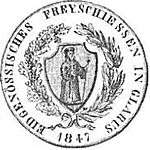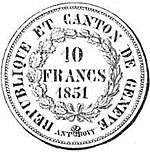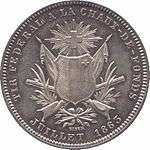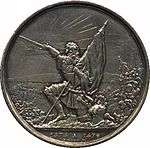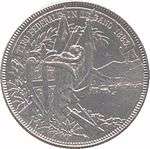
1939 Lucerne shooting thaler
A shooting thaler ( TAH-lərz; German: Schützentaler, French: Écu de tir) is a commemorative coin minted to commemorate one of the Schützenfest (French: Fête de tir) or free shooting (German: Freischiessen, French: Tir libre) tournaments held in various cantons within the Swiss Confederation. Most of the designs differ from their circulating counterparts, though the pieces issued for the shooting festivals in Geneva in 1851 and Solothurn in 1855 are exceptions. Most shooting thaler designs depict strongly cantonal or patriotic themes, such as historical military leaders or heraldry. The entire series can be distinguished from shooting medals by their adherence to the specifications of circulating coinage. All but the Stans and St. Gallen issues are denominated. Other countries have minted coins in honor of shooting festivals or marksmanship competitions, but only Swiss pieces are considered shooting thalers.
The first shooting thaler was issued for the Chur shooting festival in 1842 and is denominated at four francs. The second, issued for Glarus, has a face value of forty batzen. The third, minted for the shooting festival in Geneva, is denominated at ten francs. A total of eighteen designs were struck in the nineteenth century, concluding with the Bern issue of 1885. All those struck from 1855 to 1885 bear the denomination of five francs. Many nineteenth-century issues were also struck in various other metals besides silver, including gold and white metal, in small quantities. In 1934, a new series began production. This series, however, was cut short due to the outbreak of World War II. Another series of shooting thalers began mintage in 1984. The first coins issued in this new series were those minted for the festival at Oberhasli. Every year since has seen the mintage of two coins, each bearing the same design, one struck in silver, the other in gold. The only exceptions are the issues of Zürich and Sion in 1999, one of which was struck in copper–nickel, two in silver and two in gold. Until 1995, silver issues were denominated at fifty francs, while gold pieces were denominated at 1,000 francs. Later, gold issues were denominated at 500 francs, excepting only the Zürich issues of 1999.
History

1934 Fribourg shooting thaler. Reverse legend reads: BON DE 5Fr REMBOURSABLE AVANT LE 31 AOUT 1934 (English: Good for five francs reimbursable before August 31, 1934)
The first shooting thalers were cantonal pieces, minted by the sovereign cantons of Switzerland. All of these pieces, as well as the 1855 Solothurn issue, were strictly legal tender.[1] Nineteenth-century Confederation shooting thaler issues were minted to legal fineness, and were thus allowed to bear the denomination of five francs.[1] Beginning in 1865, Switzerland became a member of the Latin Monetary Union.[2] Shooting thalers were not included in the mintages authorized by the Union. Therefore, these issues are commonly considered semi-medallic, though they could circulate due to their size and weight being the same as that of the regular five franc issues.[1] This series of shooting thalers, following the standards of the Latin Monetary Union, began in 1855 with the Solothurn issue and ended in 1885 with the Bern issue.[1] In 1927, the Monetary Union ceased to exist.[2] Mintage began on a new series of shooting thalers in 1934 in honor of the shooting festival in Fribourg, and another design was issued in 1939 for the Lucerne festival. The 1934 issue was the last official shooting thaler that matched the circulating counterpart in both diameter and weight. The 1939 issues were not the same size and weight as their circulating counterparts, but both issues were redeemable only at the shooting festival or participating businesses.[1] Production of shooting thalers was cut short with the outbreak of World War II.[3] In 1984, a new series of shooting thalers began mintage, due largely to the efforts of California-based coin dealer Richard Nelson.[3] These issues, like those minted in 1934 and 1939, are not minted to legal fineness and are not considered legal tender.[1]
Mintage data and designs
19th-century Cantonal issues
Chur
- Year: 1842
- Location: Chur
- Denomination: 4 francs
- Designer(s): Karl Friedrich Voigt
- Diameter: 40 mm (1.57 in)
- Coinage metal: Silver
- Mintage: 4,256[4]
- Notes: White metal and zinc pieces are known to have been struck. The zinc pieces were allegedly fixed in the center of a target during the shooting festival. If hit, the shooter would be given a larger award.[4]
Chur specifications
|
Details |
Translation |
|---|
| Obverse |
EIDGENÖSSISCHES FREISCHIESSEN IN CHUR – 1842 |
Federal Free Shoot in Chur – 1842 |
| Reverse |
CANTON GRAUBÜNDEN – 4 SCHWEIZER FRANKEN |
Canton of Graubünden – 4 Swiss francs |
| Edge |
EINTRACHT MACHT STARK |
Harmony is strength |
Glarus
- Year: 1847
- Location: Glarus
- Denomination: 40 batzen
- Designer(s): S. Burger, Karl Friedrich Voigt
- Diameter: 40 mm (1.57 in)
- Coinage metal: Silver
- Mintage: 3,200[5]
- Notes: 1,023 pieces melted. White metal and zinc pieces are known to have been struck. The zinc pieces were allegedly fixed in the center of a target during the shooting festival. If hit, the shooter would be given a larger award.[5]
Glarus specifications
|
Details |
Translation |
|---|
| Obverse |
EIDGENÖSSISCHES FREYSCHIESSEN IN GLARUS – 1847 |
Federal Free Shoot in Glarus – 1847 |
| Reverse |
40 Btz. |
40 batzen |
| Edge |
EINTRACHT MACHT STARK |
Harmony is strength |
Geneva
- Year: 1851
- Location: Geneva
- Denomination: 10 francs
- Designer(s): Antoine Bovy
- Diameter: 48 mm (1.89 in)
- Coinage metal: Silver
- Mintage: 1,000[6]
- Notes: The design is identical to the regular 10 franc issues.[6]
Geneva specifications
|
Details |
Translation |
|---|
| Obverse |
POST – TENEBRAS – LUX |
Light after darkness |
| Reverse |
REPUBLIC ET CANTON DE GENEVE – 10 FRANCS 1851 |
Republic and Canton of Geneva – 10 francs 1851 |
| Edge |
None |
None |
19th-century Swiss Confederation issues
Solothurn
- Year: 1855
- Location: Solothurn
- Denomination: 5 francs
- Designer(s): Antoine Bovy
- Diameter: 37 mm (1.46 in)
- Coinage metal: Silver
- Mintage: 3,000[7]
- Notes: The design is identical to the regular 5 franc issues.[7]
Solothurn specifications
|
Inscription |
Translation |
|---|
| Obverse |
HELVETIA |
Switzerland |
| Reverse |
5 Fr. 1855 |
5 francs 1855 |
| Edge |
EIDGEN. FREISCHIESEN SOLOTHURN 1855 |
Federal free shoot Solothurn 1855 |
Bern
- Year: 1857
- Location: Bern
- Denomination: 5 francs
- Designer(s): Ferdinand Korn
- Diameter: 37 mm (1.46 in)
- Coinage metal: Silver
- Mintage: 5,191[8]
- Notes: Examples are known to have been struck in white metal.[8]
Bern specifications
|
Inscription |
Translation |
|---|
| Obverse |
EHRE IST MEIN HOECHSTES ZIEL |
Honor is my highest goal |
| Reverse |
EIDGENÖSSISCHES FREISCHIESSEN IN BERN 1857 – 5 FRANKEN |
Federal free shoot in Bern 1857 – 5 francs |
| Edge |
None |
None |
Zürich
- Year: 1859
- Location: Zürich
- Denomination: 5 francs
- Designer(s): Ferdinand Korn
- Diameter: 37 mm (1.46 in)
- Coinage metal: Silver
- Mintage: 6,000[9]
- Notes:
Zürich specifications
|
Inscription |
Translation |
|---|
| Obverse |
EIDGENÖSSISCHES FREISCHIESSEN – 1859 |
Federal free shoot – 1859 |
| Reverse |
ZÜRICH – 5 FRANKEN |
Zürich – 5 francs |
| Edge |
None |
None |
Stans
- Year: 1861
- Location: Stans
- Denomination: 5 francs
- Designer(s): Antoine Bovy, Lukas Ferdinand Schlöth
- Diameter: 37 mm (1.46 in)
- Coinage metal: Silver
- Mintage: 6,000[10]
- Notes: Essai pieces are known to have been struck in white metal.[10]
Stans specifications
|
Inscription |
Translation |
|---|
| Obverse |
ARNOLD WINKELRIED |
Arnold Winkelried |
| Reverse |
EIDGENÖSSISCHES SCHÜTZENFEST IN NIDWALDEN – 1861 |
Federal shooting festival in Nidwalden – 1861 |
| Edge |
None |
None |
La Chaux-de-Fonds
- Year: 1863
- Location: La Chaux-de-Fonds
- Denomination: 5 francs
- Designer(s): Antoine Bovy, Jacob Siber
- Diameter: 37 mm (1.46 in)
- Coinage metal: Silver
- Mintage: 6,000[11]
- Notes: Examples are known to have been struck in white metal.[11]
La Chaux-de-Fonds specifications
|
Inscription |
Translation |
|---|
| Obverse |
HELVETIA – 5 FRANCS |
Switzerland – 5 francs |
| Reverse |
TIR FEDERAL A LA CHAUX-DE-FONDS – JÚILLET 1863 |
Federal shoot in La Chaux-de-Fonds – July 1863 |
| Edge |
None |
None |
Schaffhausen
- Year: 1865
- Location: Schaffhausen
- Denomination: 5 francs
- Designer(s): Antoine Bovy
- Diameter: 37 mm (1.46 in)
- Coinage metal: Silver
- Mintage: 10,000[12]
- Notes: Two examples are known to have been struck in gold.[12]
Schaffhausen specifications
|
Inscription |
Translation |
|---|
| Obverse |
None |
None |
| Reverse |
EIDGENÖSSISCHES SCHÜTZENFEST IN SCHAFFHAUSEN 1865 – 5 Fr. |
Federal shooting festival in Schaffhausen 1865 – 5 francs |
| Edge |
None |
None |
Schwyz
- Year: 1867
- Location: Schwyz
- Denomination: 5 francs
- Designer(s): Antoine Bovy
- Diameter: 37 mm (1.46 in)
- Coinage metal: Silver
- Mintage: 8,000[13]
- Notes:
Schwyz specifications
|
Inscription |
Translation |
|---|
| Obverse |
KANTON SCHWYZ |
Canton of Schwyz |
| Reverse |
EIDGENÖSSISCHES SCHÜTZENFEST IN SCHWYZ 1867 – 5 Fr. |
Federal shooting festival in Schwyz 1867 – 5 francs |
| Edge |
None |
None |
Zug
- Year: 1869
- Location: Zug
- Denomination: 5 francs
- Designer(s): Antoine Bovy
- Diameter: 37 mm (1.46 in)
- Coinage metal: Silver
- Mintage: 6,000[14]
- Notes: Four examples are known to have been struck in gold.[14]
Zug specifications
|
Inscription |
Translation |
|---|
| Obverse |
HANS LANDWING RETTET DAS PANNER BEI ARBEDO – 1422 |
Hans Landwing saves the banner at Arbedo – 1422 |
| Reverse |
EIDGENÖSSISCHES SCHÜTZENFEST 1869 IN ZUG – 5 Fr. |
Federal shooting festival 1869 in Zug – 5 francs |
| Edge |
None |
None |
Zürich
- Year: 1872
- Location: Zürich
- Denomination: 5 francs
- Designer(s): Fritz Landry
- Diameter: 37 mm (1.46 in)
- Coinage metal: Silver
- Mintage: 10,000[15]
- Notes: The obverse design was used on a shooting medal issued for the same festival.[15]
Zürich specifications
|
Inscription |
Translation |
|---|
| Obverse |
FÜR FREIHEIT UND VATERLAND |
For freedom and the fatherland |
| Reverse |
EIDGENÖSSISCHES SCHÜTZENFEST IN ZÜRICH 1872 – 5 Fr. |
Federal shooting festival in Zürich 1872 – 5 francs |
| Edge |
None |
None |
St. Gallen
- Year: 1874
- Location: St. Gallen
- Denomination: 5 francs
- Designer(s): Fritz Landry
- Diameter: 37 mm (1.46 in)
- Coinage metal: Silver
- Mintage: 15,000[16]
- Notes:
St. Gallen specifications
|
Inscription |
Translation |
|---|
| Obverse |
1474 A 1476 |
1474 to 1476 |
| Reverse |
EIDGENÖSS. SCHÜTZENFEST IN ST. GALLEN – 1874 |
Federal shooting festival in St. Gallen – 1874 |
| Edge |
None |
None |
Lausanne
- Year: 1876
- Location: Lausanne
- Denomination: 5 francs
- Designer(s): Edouard Durussel
- Diameter: 37 mm (1.46 in)
- Coinage metal: Silver
- Mintage: 20,000[17]
- Notes: The reverse design was used on a shooting medal issued for the same festival.[17]
Lausanne specifications
|
Inscription |
Translation |
|---|
| Obverse |
POUR ETRE FORTS SOYONS UNIS – 5 F |
Let us be strong and united – 5 francs |
| Reverse |
TIR FÉDÉRAL DE 1876 LAUSANNE |
Federal shoot of 1876 Lausanne |
| Edge |
None |
None |
Basel
- Year: 1879
- Location: Basel
- Denomination: 5 francs
- Designer(s): Edouard Durussel
- Diameter: 37 mm (1.46 in)
- Coinage metal: Silver
- Mintage: 30,000[18]
- Notes: Two varieties exist. One variety depicts rays between the sword and leg, while the other does not. Examples are known to have been struck in white metal.[18]
Basel specifications
|
Inscription |
Translation |
|---|
| Obverse |
DAS SCHWERT ZUR HAND IM HERZEN GOTT SO WIRD D. SCHWEIZER NIE Z. SPOTT |
With sword in his hand and God in his heart, so will the Swiss never be disgraced |
| Reverse |
EIDG. SCHÜTZENFEST IN BASEL 1879 – 5 Fr. |
Federal shooting festival in Basel 1879 – 5 francs |
| Edge |
None |
None |
Fribourg
- Year: 1881
- Location: Fribourg
- Denomination: 5 francs
- Designer(s): Edouard Durussel
- Diameter: 37 mm (1.46 in)
- Coinage metal: Silver
- Mintage: 30,000[19]
- Notes:
Fribourg specifications
|
Inscription |
Translation |
|---|
| Obverse |
ENTRÉE DE FRIBOURG & SOLEURE DANS LA CONFÉDÉRATION SUISSE – 1481 |
Entry of Fribourg and Solothurn into the Swiss Confederation – 1481 |
| Reverse |
TIR FÉDÉRAL À FRIBOURG 1881 – 5 Fr |
Federal shoot in Fribourg 1881 – 5 francs |
| Edge |
None |
None |
Lugano
- Year: 1883
- Location: Lugano
- Denomination: 5 francs
- Designer(s): Edouard Durussel
- Diameter: 37 mm (1.46 in)
- Coinage metal: Silver
- Mintage: 30,000[20]
- Notes:
Lugano specifications
|
Inscription |
Translation |
|---|
| Obverse |
LIBERTADE INERME É DE' TIRANNI AGEVOL PREDA – 5 Fr. |
Defenseless liberty is easy prey for tyrants – 5 francs |
| Reverse |
TIRO FEDERALE IN LUGANO 1883 |
Federal shoot in Lugano 1883 |
| Edge |
None |
None |
Bern
- Year: 1885
- Location: Bern
- Denomination: 5 francs
- Designer(s): Edouard Durussel, Christian Bühler
- Diameter: 37 mm (1.46 in)
- Coinage metal: Silver
- Mintage: 25,000[21]
- Notes: Examples are known to have been struck in white metal.[21]
Bern specifications
|
Inscription |
Translation |
|---|
| Obverse |
DEM BUND ZUM SCHUTZ DEM FEIND ZUM TRUTZ |
The Federation to protect, the enemy to defy |
| Reverse |
EIDGENÖSSISCHES SCHÜTZENFEST IN BERN 1885 – 5 Fr. |
Federal shooting festival in Bern 1885 – 5 francs |
| Edge |
None |
None |
20th- and 21st-century Swiss Confederation issues
Later thalers with event location and year, showing denomination, metal, number struck and Standard Catalog of World Coins reference number
| Location |
Date |
Denomination |
Coinage metal |
Mintage[22] |
KM number |
Haberling number |
|---|
| Fribourg |
1934 |
000055 francs |
Silver |
40,650 |
S18 |
H20a |
| Fribourg |
1934 |
00100100 francs |
Gold |
2,000 |
S19 |
H21 |
| Lucerne |
1939 |
000055 francs |
Silver |
40,000 |
S20 |
H22 |
| Lucerne |
1939 |
00100100 francs |
Gold |
6,000 |
S21 |
H23 |
| Oberhasli |
1984 |
0005050 francs |
Silver |
6,300 |
S22 |
H24a & H24b |
| Oberhasli |
1984 |
010001,000 francs |
Gold |
300 |
S23 |
H25 |
| Altdorf |
1985 |
0005050 francs |
Silver |
3,500 |
S24 |
H26a |
| Altdorf |
1985 |
010001,000 francs |
Gold |
300 |
S25 |
H27 |
| Appenzell |
1986 |
0005050 francs |
Silver |
3,700 |
S26 |
H28a |
| Appenzell |
1986 |
010001,000 francs |
Gold |
300 |
S27 |
H29 |
| Glarus |
1987 |
0005050 francs |
Silver |
3,200 |
S28 |
H1a |
| Glarus |
1987 |
010001,000 francs |
Gold |
300 |
S29 |
H32 |
| Brugg |
1988 |
0005050 francs |
Silver |
3,000 |
S30 |
H33a & H33b |
| Brugg |
1988 |
010001,000 francs |
Gold |
400 |
S31 |
H34 |
| Menzingen |
1989 |
0005050 francs |
Silver |
2,200 |
S32 |
H36a & H36b |
| Menzingen |
1989 |
010001,000 francs |
Gold |
250 |
S33 |
H37 |
| Winterthur |
1990 |
0005050 francs |
Silver |
5,000 |
S34 |
H39a |
| Winterthur |
1990 |
010001,000 francs |
Gold |
400 |
S35 |
H40a |
| Langenthal |
1991 |
0005050 francs |
Silver |
4,000 |
S38 |
H41a |
| Langenthal |
1991 |
010001,000 francs |
Gold |
400 |
S39 |
H42a |
| Dielsdorf |
1992 |
0005050 francs |
Silver |
1,750 |
S40 |
H43a & H43b |
| Dielsdorf |
1992 |
010001,000 francs |
Gold |
175 |
S41 |
H44 |
| Weinfelden |
1993 |
0005050 francs |
Silver |
2,200 |
S42 |
H45a |
| Weinfelden |
1993 |
010001,000 francs |
Gold |
200 |
S43 |
H46 |
| Rorschach |
1994 |
0005050 francs |
Silver |
2,200 |
S44 |
H47a |
| Rorscach |
1994 |
010001,000 francs |
Gold |
200 |
S45 |
H48 |
| Thun |
1995 |
0005050 francs |
Silver |
5,000 |
S46 |
H49a |
| Thun |
1995 |
00500500 francs |
Gold |
500 |
S47 |
H50 |
| Sempach |
1996 |
0005050 francs |
Silver |
1,500 |
S48 |
H51a |
| Sempach |
1996 |
00500500 francs |
Gold |
96 |
S49 |
H52 |
| Neuhausen am Rheinfall |
1997 |
0005050 francs |
Silver |
1,500 |
S50 |
H53a |
| Neuhausen am Rheinfall |
1997 |
00500500 francs |
Gold |
97 |
S51 |
H54 |
| Schwyz |
1998 |
0005050 francs |
Silver |
1,500 |
S52 |
H55 |
| Schwyz |
1998 |
00500500 francs |
Gold |
98 |
S53 |
H56a |
| Zürich |
1999 |
000055 francs |
Copper–Nickel |
2,500 |
S54 |
H57 |
| Zürich |
1999 |
0002020 francs |
Silver |
1,000 |
S55 |
H58 |
| Sion |
1999 |
0005050 francs |
Silver |
1,500 |
S57 |
H60 |
| Zürich |
1999 |
00200200 francs |
Gold |
100 |
S56 |
H59 |
| Sion |
1999 |
00500500 francs |
Gold |
99 |
S58 |
H61a |
| Bière |
2000 |
0005050 francs |
Silver |
3,500 |
S59 |
H62 |
| Bière |
2000 |
00500500 francs |
Gold |
300 |
S60 |
H63a |
| Altdorf, Uri |
2001 |
0005050 francs |
Silver |
1,500 |
S61 |
H64 |
| Altdorf, Uri |
2001 |
00500500 francs |
Gold |
150 |
S62 |
H65a |
| Zürich |
2002 |
0005050 francs |
Silver |
1,500 |
S63 |
H66 |
| Zürich |
2002 |
00500500 francs |
Gold |
150 |
S64 |
H67a |
| Liestal |
2003 |
0005050 francs |
Silver |
1,500 |
S65 |
H68 |
| Liestal |
2003 |
00500500 francs |
Gold |
150 |
S66 |
H69a |
| Fribourg |
2004 |
0005050 francs |
Silver |
1,500 |
S67 |
H70a & H70b |
| Fribourg |
2004 |
00500500 francs |
Gold |
150 |
S68 |
H71a |
| Brusio |
2005 |
0005050 francs |
Silver |
1,500 |
S69 |
H72a & H72b |
| Brusio |
2005 |
00500500 francs |
Gold |
150 |
S70 |
H73 |
| Solothurn |
2006 |
0005050 francs |
Silver |
2,000 |
S71 |
H74a |
| Solothurn |
2006 |
00500500 francs |
Gold |
200 |
S72 |
H75a & H75b |
| Lucerne |
2007 |
0005050 francs |
Silver |
2,000 |
S73 |
H77a |
| Lucerne |
2007 |
00500500 francs |
Gold |
200 |
S74 |
H78 |
| Geneva |
2008 |
0005050 francs |
Silver |
1,500 |
S75 |
H79a |
| Geneva |
2008 |
00500500 francs |
Gold |
150 |
S76 |
H80a |
| Obwalden |
2009 |
0005050 francs |
Silver |
1,500 |
S77 |
H81a |
| Obwalden |
2009 |
00500500 francs |
Gold |
175 |
S78 |
H82a |
| Aarau |
2010 |
0005050 francs |
Silver |
2,000 |
S79 |
H83a |
| Aarau |
2010 |
00500500 francs |
Gold |
200 |
S80 |
H84a |
| Uri |
2011 |
0050050 francs |
Silver |
1,500 |
- |
H85a |
| Uri |
2011 |
00500500 francs |
Gold |
150 |
- |
H86a |
| Graubünden[23] |
2012 |
0050050 francs |
Silver |
1,500 |
- |
H87a & H87b |
| Graubünded[23] |
2012 |
00500500 francs |
Gold |
175 |
- |
H88a & H88b |
| Lucerne[23] |
2013 |
0050050 francs |
Silver |
1,000 |
- |
H89a |
| Lucerne[23] |
2013 |
00500500 francs |
Gold |
150 |
- |
H90a |
| Schaffhausen |
2014 |
0050050 francs |
Silver |
1,200 |
- |
H91a |
| Schaffhausen |
2014 |
00500500 francs |
Gold |
180 |
- |
H92a |
| Valais[24] |
2015 |
0050050 francs |
Silver |
1,200 |
- |
H93a |
| Valais[24] |
2015 |
00500500 francs |
Silver |
200 |
- |
H94a |
Etymology
Though no coins denominated as thalers were officially issued within the Swiss Confederation, many coins measuring between 30 and 40 millimeters have been given the name unofficially due to the similarity in size to German and Austrian thalers.[25]
Shooting medals
The first shooting medals were struck in honor of the Officers' Shoot held in Langenthal, Bern, in 1822.[26] They can usually be distinguished from shooting thalers by their lack of denomination and difference in weight and often composition, though there is evidence that many of thaler-size did circulate amongst the legal tender coins of Switzerland.[25] Shooting medals were minted in a variety of metals, including silver, bronze, goldene and white metal.[26]
Other countries
Though not considered shooting thalers, some other European coin-issuing entities have minted coins to honor or promote shooting festivals that took place within their territory. Examples include the German States of Baden,[27] Bremen,[28] Frankfurt am Main[29] and Hanover,[30] as well as the Swiss canton of Vaud.[17]
See also
References
- 1 2 3 4 5 6 Bruce, p. 455
- 1 2 Kenen, Peter B. & Meade, Ellen E. (2008). Regional Monetary Integration Cambridge, United Kingdom: Cambridge University Press. ISBN 0-521-86250-7
- 1 2 Searis, BJ. "Swiss Shooting Thalers". Professional Coin Grading Service. Retrieved 2015-02-27.
- 1 2 Richter, p. 161
- 1 2 Richter, p. 156
- 1 2 Richter, p. 113
- 1 2 Richter, p. 209
- 1 2 Richter, p. 60
- ↑ Richter, p. 299
- 1 2 Richter, p. 193
- 1 2 Richter, p. 180
- 1 2 Richter, p. 199
- ↑ Richter, p. 202
- 1 2 Richter, p. 293
- 1 2 Richter, p. 301
- ↑ Richter, p. 215
- 1 2 3 Richter, p. 274
- 1 2 Richter, p. 45
- ↑ Richter, p. 93
- ↑ Richter, p. 245
- 1 2 Richter, p. 62
- ↑ Bruce, pp. 456–460
- 1 2 3 4 "Swiss shooting taler available". Coin World. Retrieved 2015-02-27.
- 1 2 "Swiss shooting talers for 2015 mark festival in Wallis (Valais)". Coin World. Retrieved 2015-02-27.
- 1 2 Krause, p. 10
- 1 2 Krause, p. 11
- ↑ Krause & Mishler, p. 355
- ↑ Krause & Mishler, p. 373
- ↑ Krause & Mishler, p. 383
- ↑ Bruce, p. 155
Bibliography
- Bruce, Colin R. II Unusual World Coins Iola, Wisconsin: Krause Publications, 2007, ISBN 0-89689-576-9
- Krause, Chester L. & Mishler, Clifford Standard Catalog of World Coins 1801–1900, Krause Publications, 1996, ISBN 0-87341-427-6
- Krause, Delbert Ray Swiss Shooting Talers and Medals, Whitman Publishing Company, 1965
- Martin, Jean L. Les médailles de tir Suisse 1612–1939 Lausanne, 1972
- Richter, Jürg Die Schützentaler und Schützenmedaillen der Schweiz, 2005, ISBN 3-924861-95-1
- Haberling, Michael Swiss Shooting Festival Coins 1842 - 2015, 2015
External links




